You’ve ticked off some major milestones recently. You’ve jumped through the hoops to get a budget for team training. Amazing! You’ve done the research and landed on an LMS platform winner. You’ve briefed your team, got them enthusiastic, and onboarded them to the training platform. Well done. Now it’s been a few months, and you’re asked to provide a report on the success of the training so far and its return on investment (ROI). But how do you measure team training ROI?
Let’s get into it.
| Table of Contents |
|---|
| What is Training ROI? |
| Why Measure Training ROI? |
| 4 Ways to Measure Training ROI |
| Key Training Metrics and Indicators |
| Optimize Your Training Investments |
What is training ROI?
Training ROI is the return on the money you invested in training and development. It calculates the value generated from employee training and then weighs that value against training costs.
Training ROI (return on investment) is the financial benefits earned from the money you've invested in training and development initiatives.
Generated value refers to the net benefits of training and includes increased productivity, improved performance, saved work hours, and other gains that can be attributed to the training. On the other hand, training costs include expenses related to the development, delivery, and management of training programs.
Why measure training ROI?
Having the right data to inform decisions is crucial for business performance and growth across the board, including your team training. Calculating the training ROI helps determine whether the relevant training resource is a good investment.
It also offers insight into whether the resource is being used correctly, whether it’s helping with employee productivity and KPIs, and whether there’s room for improvement.
Measuring the training ROI helps give you a clear and comprehensive view of the benefits (or lack thereof) delivered by your training initiative. With that data, you can make better business decisions, optimize your current training strategies, and showcase the positive impact professional development has had on your company’s bottom line.
The GoSkills LMS makes it easier to calculate training ROI through its rich reporting functions. From the littlest details to overall aggregate reporting, you’ll find all the data you need to make better training decisions. This data-backed approach benefits every stakeholder type: learners, course creators, training managers, and tech buyers.
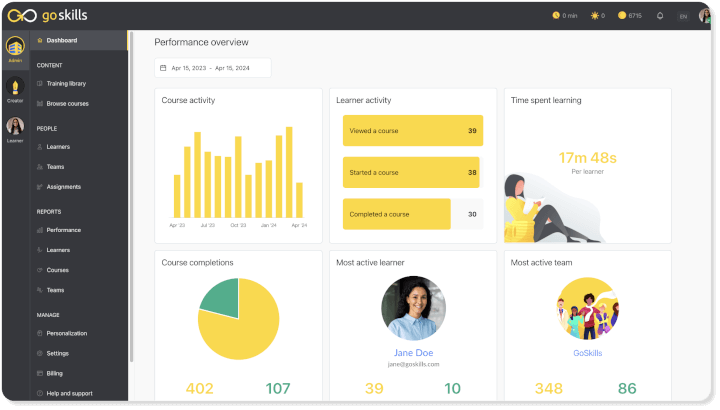
It helps increase learning speeds and retention rates by 28% and 20%, respectively, while achieving some of the highest completion rates in the industry. It helps drive continuous improvement in the quality and impact of courses. And it helps build the case for adoption or validate prior purchase decisions.
4 ways to measure training ROI
Measuring ROI has often been a critical challenge for many businesses. When it comes to talent development, determining the return on your training investments can be as easy as using a training ROI calculator. On the other hand, calculating ROI can also be complicated when your computations include many factors that are difficult to track or measure.
There are several methods for calculating team training ROI. Let’s dive into some of them.
1. Traditional ROI formula
A basic formula to calculate ROI on team learning is to deduct the training cost from the value of the program’s benefits, and then divide that number by the program cost. While this formula can help calculate how much your training program is contributing to the company’s performance, it tends to exclude non-tangible benefits.
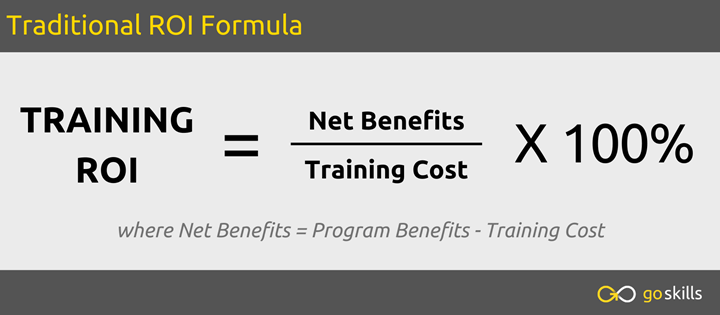
2. The Kirkpatrick model
The Kirkpatrick Model rates formal and informal training methods against four criteria levels: reaction, learning, behavior, and results.
- The reaction phase measures whether your learners find the team training engaging and relevant, and it’s often assessed by a survey done after the training is complete.
- The learning phase measures whether your learners are taking in new knowledge, understanding the content, and if they’re committed to the training. It’s often evaluated through pre-learning and post-learning assessments through exams or interview-style evaluations.
- The behavior phase measures the training program’s impact on your learners and whether they’re able to apply what they’ve learned at work.
- The results phase measures exactly that: direct results. They’re compared against business outcomes and KPIs such as a higher return on investment, more sales, or higher employee satisfaction.
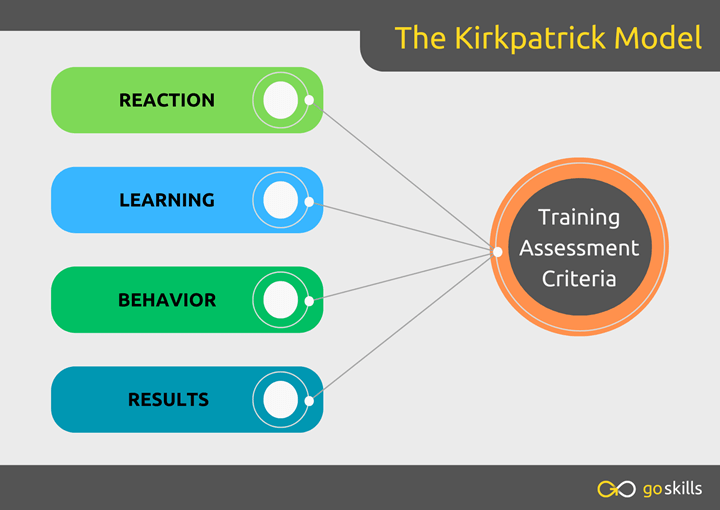
3. Phillips’ ROI methodology
Phillips’ ROI methodology expands on the four steps of the Kirkpatrick Model. For its fifth element, this method calculates the net return on investment by comparing the benefits of a training program to its cost:
- Reaction and planned action. Measures how satisfied your learners are and how committed they are to applying what they learn to their work.
- Learning and evaluation. Measures whether learners have learned new concepts or skills.
- Application and implementation. Measures to what extent your learners are applying what they have learned.
- Impact. Measures the impact of your team training program on organizational goals and performance indicators.
- Calculation. Measures the financial return of your training program compared to the cost of running it.
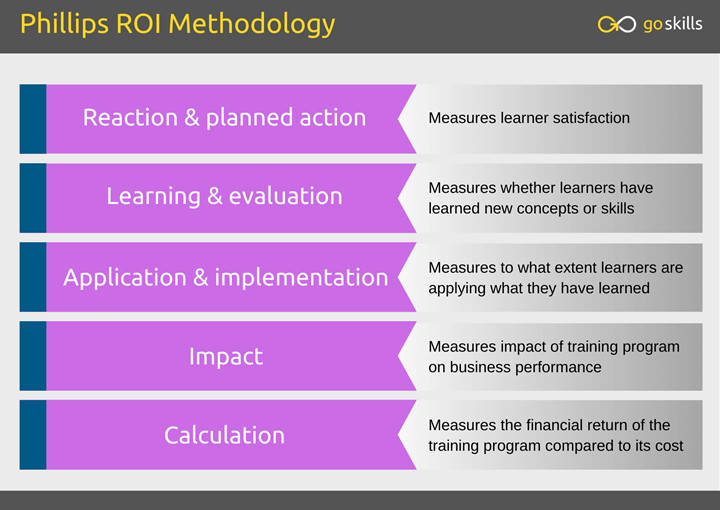
4. The ADDIE model
The ADDIE Model is an iterative approach for evaluating the ROI of your training program. It consists of five stages:
- Analysis: identifying training needs, understanding learners, and defining goals.
- Design: creating a detailed plan and choosing assessment methods.
- Development: creating training materials and/or online courses.
- Implementation: delivering the training program.
- Evaluation: assessing the effectiveness and adequacy of the training program.
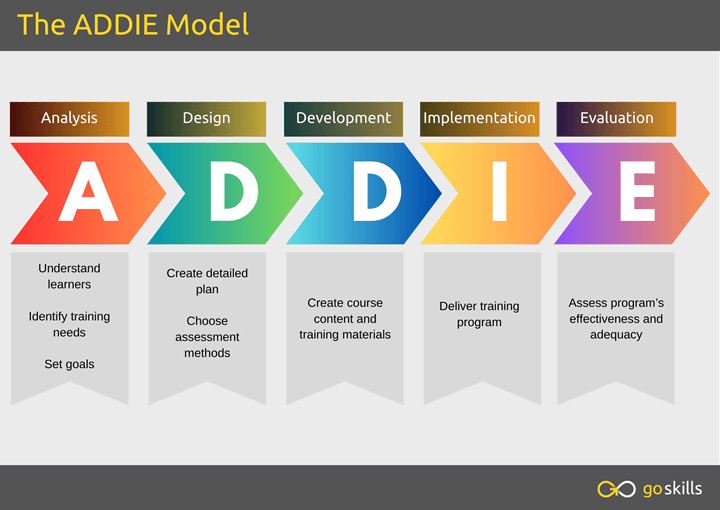
Key training metrics and indicators
There are many ways of assessing the performance of training programs. That means the set of metrics and indicators used by one company to evaluate its training efforts will likely differ from that used by another organization.
For example, course-driven training programs are evaluated using several essential metrics such as engagement level, knowledge retention, and course completion rates.
On the other hand, some companies adopt a specific model or framework in evaluating the success of their training programs. For example, the following criteria are based on (with some deviation) the Kirkpatrick model:
- Attendance and participation rates. If no one shows up at your training event, logs into the training platform, or finishes any module or course, then things aren’t looking good. Excellent learning management systems (LMS) like GoSkills enable businesses to track these activities to measure learners’ engagement with a specific course over a specific timeframe. Moreover, GoSkills help drive learner engagement using techniques such as microlearning, gamification, and social learning.
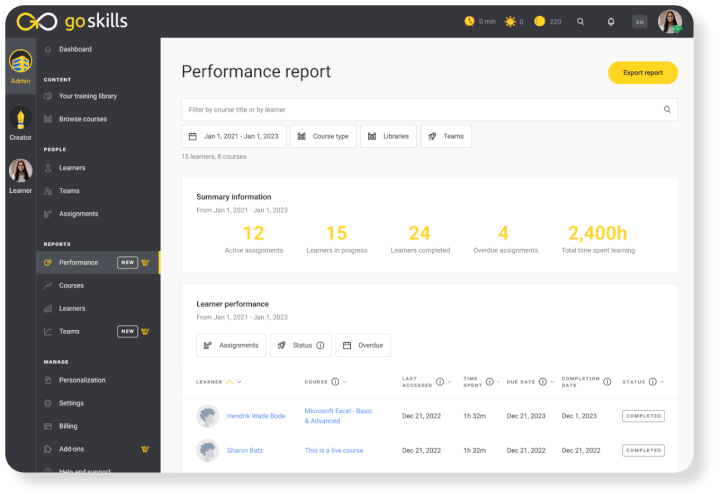
- Reaction. This criterion indicates the level of interest and engagement in the program you’ve chosen or put together.
- Learning. This criterion may encapsulate several metrics such as knowledge retention. Assessment methods such as tests, quizzes, focus groups, and surveys are used to measure retention rates.
- Behavior change. Learning comes in many forms and leads to different outcomes. Those that drive change in a learner’s behavior or performance are the ones that matter. Behavior change indicates whether employees are applying the knowledge and skills they have learned and how that impacts their work. You can use performance reviews and general observation, among others, to track this metric.
- Business impact. Business impact is measured by analyzing whether (and how much) your training program affected the company’s business performance as reflected in its key performance indicators (KPIs). For the most part, this measure shows the tangible impact of your training program on the organization’s top and bottom-line figures.
Advanced LMS platforms like GoSkills eliminate the guesswork when it comes to identifying and measuring the metrics that matter. The GoSkills dashboard serves different stakeholders – learners, course creators, and administrators – by providing relevant data and reports.
If you’re an admin, you’ll have access to the platform’s analytics engine that lends visibility into all aspects of your training programs including total time spent on courses, total course completion data, and in-progress training.
If you’re a creator, you’ll be able to generate data-driven reports related to the courses you’ve developed using a native template gallery and a powerful AI content authoring assistant. As a learner, you can readily access information on the courses assigned to you, the ones you are currently taking, the courses you have completed (with relevant timestamps), and all the milestones you have achieved as a learner.
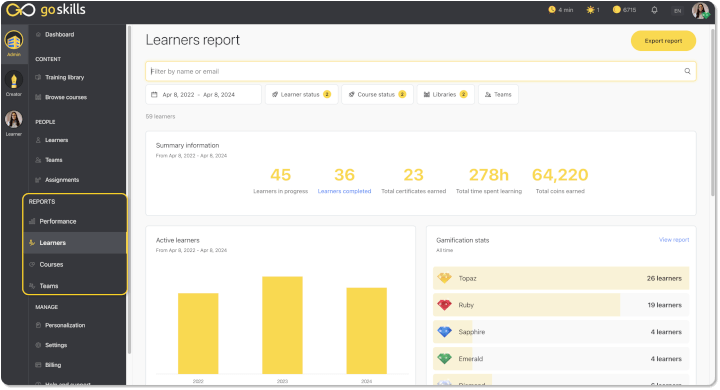
Optimize your training investments
Guided by the results of an ROI analysis, you can optimize training to improve your return on investment.
Some key questions to address:
1. Are your training tools easy to use, interactive, and of high quality?
Research has shown that organizations that provide their employees with high-quality training are also significantly better at creating an environment with higher worker retention rates, which further improves team training ROI.
The GoSkills LMS is an all-in-one elearning solution that helps you organize all your training in one central place. Cloud-based and mobile-friendly, it enables your team to learn at any time, from any device, and at their own pace. If you want to scout the market, here’s a shortlist of top-rated learning experience platforms that might squarely meet your unique business needs.
2. Does your training specifically align with your business objectives?
According to Boston Consulting Group (BCG), companies with a continuous-learning infrastructure can “attract and keep the best talent—and create lasting competitive advantage.” But to achieve this, a learning system should be “unique and customized,” and “employees need relevant, personalized, easily digestible lessons ingrained into the everyday rhythm of their daily work.” This, of course, entails a highly adaptable learning platform that makes it easier to fine-tune training programs and lesson content as business needs and objectives change.
A microlearning pioneer, GoSkills provides a flexible system that delivers virtually any form of learning content, from multi-lesson courses to bite-sized videos and interactive quizzes.
3. Have you addressed non-training factors that also contribute to employee performance and affect training outcomes?
Aside from training, other factors—both tangible and intangible—can help employees excel at work. These include competitive compensation, a positive work culture, trust, transparency, community, and opportunities for professional development.
Because these factors can influence the ROI of training programs, it is important to address them while also rolling out a program. If your employees are happy at work, they’ll likely show better engagement with your team training initiatives and report higher satisfaction rates.
4. Do you know the essential features a good training platform should possess, and do you use these as buying criteria to guide your purchase decisions?
Good training platforms that deliver excellent ROI have many things in common. They tend to be learner-centric solutions with the following features and characteristics:
- Engaging experience for learners
- High degree of personalization
- Built-in library of high-quality courses
- Social learning capabilities
- Scalable and reasonably priced
- Easy integration with existing systems
- Robust reporting and analytics
- Track record of customer success
Want to boost your team's success?
Learn why training and development matters (and how to do it right)!
Learning platforms that facilitate engaging experiences for learners through gamification, microlearning, and other techniques help improve course completion and learning retention rates, thereby improving ROI figures. Solutions that also enhance the capabilities of administrators and instructional designers through robust reporting and AI-driven course authoring tools optimize the business benefits of your investment.
Wrapping up
A data-driven approach to learning makes all the difference in measuring your team training ROI. Start by being clear about the learning objectives. Then, pick the best methodology for evaluating and improving your results. If you have yet to select an LMS, you can stay on the safe side and minimize risk by making the most of a free trial or free plan before going full throttle with a paid subscription.
Curious about GoSkills pricing? Check out which LMS plan will offer the best ROI for your team.
A better way to train
It's easier than ever to create, track, and manage team training with the GoSkills LMS.
Start for free



